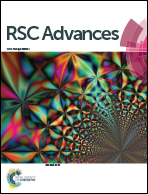Study of the molecular array behaviour of laurel alkanolamide at the oil–water interface and the high interfacial activity enhanced by an inherent synergistic effect†
Abstract
The interfacial activity of surfactants is an issue that attracts considerable attention. However, most of the literature focuses on pure surfactants, and the effect of impurities on surfactant activity remains an elusive puzzle in the understanding of structure–performance relationships. In this paper, the nonionic surfactant laurel alkanolamide (LAA) synthesized by a one-step method was found to decrease the oil–water interfacial tension to ultra-low values at low concentration without co-surfactants. LAA also had surprising oil phase adaptability, making it a perfect model not only to study the theoretical mechanism for obtaining ultra-low interfacial tension, but also for distinguishing the contribution of the molecular interfacial array behaviour of surfactants and concomitants (defined as the residual reactants and by-product) on the interfacial activity. The oil–water interfacial activity of LAA with or without concomitants was investigated experimentally and theoretically using dissipative dynamic simulation (DPD). The detailed molecular array behaviour of LAA and the concomitants at the oil–water interface was investigated by molecular dynamics (MD). The concomitants were found to coexist with LAA at the oil–water interface and distribute at different positions in the interfacial layer, resulting in the high interfacial activity and oil phase adaptability. The experimental results agree well with the simulation results. We hope our strategy can provide an avenue to understand the structure–performance relationship of surfactants at the molecular level and reveal an effective approach to obtaining ultra-low interfacial tensions with different oil phases.


 Please wait while we load your content...
Please wait while we load your content...